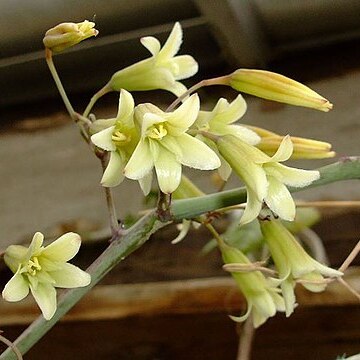Sub-herbaceous climber 0.2-3 m growing from a variable tuber. Leaves beneath greyish to glaucous, densely punctate or not, deeply (3-)5-parted or (pseudo-) foliolate, in outline suborbicular with cordate base, 4-18 x 3-17 cm; leaflets variable, entire to deeply (2-)3-5(-10)-lobed, ovate or obovate to linear, base long-attenuate or acute, apex rounded to acute, 1.5-15 x 0.7-4(-7) cm, margin entire, petiolule up to 2 cm; petiole 1-9 cm. Glands at blade-base 2, on two separate ± upward directed auricles 1-2 mm diam. at the transition of petiole to blade; blade-glands 2-4, situated between the insertions of the leaflets, and each leaflet with 0-8 glands, scattered or submarginal. Stipules narrowly triangular to lanceolate, acute, 1-3 mm, withering. Inflorescences peduncled for up to 7 cm, (1-)5-20(-60)-flowered in ('male'), 1-10-flowered in ('female'); tendril 1.2-10 cm, sterile tendrils up to 15 cm. Male flowers tubular-infundibuliform, including the 3-12 (-15) mm long stipe (14-) 20-38 mm; hypanthium cup-shaped, (1-) 2-3.5 x 2-4(-5) mm; calyx-tube (5-)8-12 mm; calyx lobes ovate or oblong to lanceolate, (sub)obtuse, (4-)7-11 mm, dentate or fimbriate; 6-12 mm, (4-)7-11 mm, dentate or fimbriate, 6-12 mm, (1-)3-nerved, inserted at the same level as, or up to 5 mm above the corona; filaments 3.5-9(-12) mm, connate for at least half-way, inserted on an androgynophore 1-3.5 mm; anthers 3-6 mm ± inward curved and at the top clinging by the c. 0.2 mm long papillate apiculate; septa 0.5-3 mm high; corona hairs c. 0.5-2 mm, rarely absent; disc-glands 0.5-1.5 mm. Hermaphrodite flowers 20-25 mm. Female flowers tubular-infundibuliform, including the 2-7 mm, 1(-3)-nerved, inserted at the same level as, or up to 4 mm above the corona; staminodes 3-5 mm, up to 1 mm connate; septa up to 0.5 mm high corona hairs 0.3-1 mm; disc-gland c. 1 mm high; gynophore 2-4 mm; ovary ovoid to oblong, (4-)5-6 mm; styles connate for 1-1.5 mm, style-arms 1-1.5 mm; stigmas subreniform woolly-papillate, each 2-3 mm diam. Fruit 1-3 per inflorescence, ovoid to ellipsoid (to oblong), excluding the (2-)5-12 mm long gynophore (2.5-)3-5.5(-7.5) x (1.5)2-3.5(-4) cm; pericarp coriaceous, brilliant yellow to red when fresh, sometimes spongy inside, smooth; seeds (10-)20-60 per capsule, (ob)ovate to ellipsoid, 6-8 mm.
Male flower: (14)20–38 × 3–10 mm. (incl. the 3–12(15) mm. long stipe), tubular-infundibuliform; hypanthium (1)2–3·5 × 2–4(5) mm., cup-shaped; calyx-tube (5)8–12 mm. long; calyx-lobes (4)7–11 mm. long, ovate or oblong to lanceolate, obtuse, dentate-fimbriate at the margin; petals 6–12 × (1)1·5–2·5 mm., lanceolate, l(3)-nerved, dentate or fimbriate at the margin, inserted at the level of the corona or up to 5 mm. above it; corona consisting of short hairs, or rarely absent; stamen-filaments 3·5(9–12) mm. long, connate at the base for (1·5)2·5–7 mm., inserted on an androgynophore 1–3·5 mm. long; anthers 3–6 × 1(1·5) mm., ± curved inward, clinging together by the 0·2 mm. long papillate apicula; disk-glands 0·5–1·5 mm. long; vestigial ovary 0·5–1 mm. long, on a gynophore up to 1·5 mm. long.
Female flower: 15–26 × 5–6 mm. (incl. the 2–7 mm. long stipe), tubular-infundibuliform; hypanthium 2–4 × 2–4 mm.; calyx-tube 4–8 mm. long; calyx-lobes 5–7 mm. long, ovate to oblong, obtuse, entire; petals 2–7 × 0·35–1 mm., lanceolate to linear, acute, 1(3)-nerved, entire or serrulate to the apex, inserted at the same level as the corona or up to 4 mm. above it; corona as in male flower; disk-glands c. 1 mm. long; pistil 8–12 mm. long; gynophore 2–4 mm. long; ovary (4)5–6 × (2)3–4 mm., ovoid to oblong; styles connate for 1–1·5 mm. at the base with arms 1–1·5 mm. long and stigmas 2–3 mm. in diameter, subreniform, woolly-papillate.
Leaf-lamina 4–18 × 3–17 cm., deeply (3)5-partiteor-foliolate, suborbicular or 5-gonal in outline, cordate at the base, membranous to coriaceous, green to yellowish-green above, yellowish, greyish or glaucous beneath, with 5 main nerves from the base; leaflets very variable in form and size, 1·5–15 × 0·75–4(7) cm., entire to ± deeply (2)3–5(10)-lobed, ovate or obovate to linear, rounded or acute sometimes mucronate at the apex, attenuated into a petiolule up to 2 cm. long, with 2–12 pairs of nerves and indistinct reticulation; petiole 1–9 cm. long.
A climber. It grows from a tuber and can be 3 m tall. The tuber is 10 cm long by 6 cm wide. The stems usually grow annually. The leaf blade is 4-18 cm long by 3-17 cm wide. They are deeply divided. They are greenish-yellow above and more grey underneath. The leaflets vary in shape. The fruit is a capsule. It can be 5 cm long by 4 cm wide and oval. It can contain 20-60 seeds. The seeds are 5-8 mm long by 5 mm wide and 3 mm thick. They are oval.
Glands of the lamina-base 2, 0·5–1·5 mm. in diameter, on 2 separate auricles 1–2 mm. in diameter situated at the transition between petiole and lamina; other glands: 2–4, 0·5–1·5 mm. in diameter, on the basal part of the lamina between the insertion of the leaflets, and 0–8 on each leaflet, irregularly scattered or submarginal.
Cymes (l)5–20(60)-flowered in male, 1–10-flowered in female, the flowers cream, yellow or orange, purplish-green at the base; peduncle stout, up to 7 cm. long; bracts and bracteoles 1·5–3 mm. long, lanceolate, acute; pedicels 1–15 mm. long in male flowers, 1–6 mm. long in female tendril 1, 2–10 cm. long.
Herbaceous, climber, 0.2-3.0 m high. Glands at leaf base 2, at transition of petiole to blade. Leaves palmately (3-)5-parted or-foliolate. Flowers white, green, yellow or cream.
Capsule (2·5)3–5·5(7·5) × (1·5)2–3·5(4) cm., ovoid to ellipsoid, greenish-yellow, with smooth coriaceous pericarp up to 4 mm. thick, (10)20–60-seeded.
Stems usually annual, the fertile ones 1·5–5 mm. in diameter, greenish or greyish, and with inter-nodes 1·5–12 cm. long.
Subherbaceous climber 0·2–3 m., arising from a tuber c. 10 × 6 cm.
Seeds 5–8 × 4·5–6·5 x 3 mm., ovoid to ellipsoid, pitted.
Stipules 1–3 mm. long, triangular, acute.
Hermaphrodite flowers 20–25 mm. long.
Sterile tendrils up to 15 cm. long.

